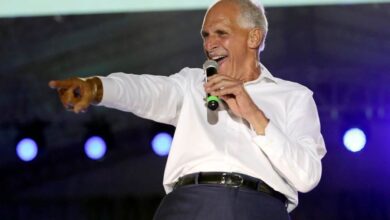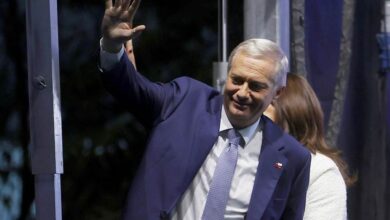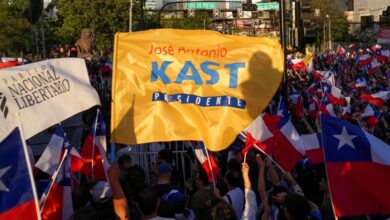Biggest winners and losers after the Peruvian elections
The second round will face Professor Pedro Castillo and the daughter of former dictator Alberto Fujimori, Keiko .

Faced with such a complex panorama, there are a number of winners and many losers in the elections. Photo: TW-Arturo_Car1
LatinAmerican Post | Santiago Goméz Hernández
Listen to this article
Leer en español: ¿Quién ganó y quién perdió en las elecciones peruanas?
You can say whatever you want about the Peruvian elections, except that they are boring. It's like watching a soap opera for Latinos only. A president who came to power after the resignation of a former leader, then a political impeachment in the midst of a global pandemic, followed by the rise and fall of a new president due to protests against him. Finally, a president who rises to power transitionally to weather the storm and call for a general election where 18 candidates compete, without any clear favorite and with a winner in the second round that few expected and who will compete against the daughter of a former dictator who has been embroiled in corruption scandals.
All this is the Peru of the last year and we still do not know if we are approaching the end of this season.
No olvidar que Castillo es un dirigente sindical.
Y un dirigente sindical sabe bien una cosa: negociar.
¿Podrá Keiko Fujimori aprender esa habilidad en pocos días cuando nunca la ha practicado?
¿Quién negociará mejor y mas rápido?
Dos cosas a obtener: bancada y voto del centro.— Rosa María Palacios (@rmapalacios) April 12, 2021
You may also be interested: What is at stake in the Peruvian elections?
Like a good novel, the casting for this last election was quite diverse. 18 candidates, men and women, from different political affiliations and each one with a particularity. From a former soccer goalkeeper to a faithful member of Opus Dei (a conservative group belonging to the Catholic Church), and even the daughter of a dictator. Faced with such a complex panorama, there are a number of winners and many losers in the elections.
Winners
Pedro Castillo. Obviously, the big winner was Pedro Castillo, the leader of the Peru Libre party. Castillo was the most voted candidate in the first round and is the favorite (without much difference) to be the next president of Peru. His low visibility in the polls showed that his electoral power was achieved in the regions. Additionally, Castillo's party achieved 16.63% in Congress and is the first legislative force (although it must create a coalition to govern).
Keiko Fujimori. The daughter of former President Alberto Fujimori managed, against all odds, to be second and will be able to compete, for the third time in a row, for the presidency. However, a large part of her success or failure hinges on reducing the anti-Fujimori vote, her main enemy in the last elections and the reason that she was beaten by Pedro Pablo Kuczynski (center right).
Fujimorism . Keiko's success shows that Fujimorism has not died and that it seems to be taking a new breath. In the legislative elections, they even got 10% of the votes, being the second most voted party. All this, despite the corruption scandals that plague various party members, including Keiko herself, who is accused of money laundering and receiving money for her previous campaign from Odebrecht.
Rafael López Aliaga. One of the most controversial candidates. Porky, as he called himself, surprised many with his third (or fourth, depending on the latest scrutiny) place in his first attempt to break into politics. López Aliaga, who represents traditional Latin American conservatism, close to the values of the Catholic Church, will be an important piece at the time of the elections for the second round, since Keiko will have to convince many right-wing voters who do not see her favorably . The leader of Renovación Popular will be able to impose a political agenda close to him in exchange for supporting Fujimori.
Popular Action. Despite the fact that its candidate Yonhy Lescano disappointed in the presidential elections, the shovel party achieved 10% of the votes in congress and is consolidated as the 2nd (or third, waiting for the entire count) legislative force and will be vital when creating a coalition or opposition, depending on who wins the second round.
Losers
Yonhy Lescano . The leader of the Popular Action party was the great loser of the night. His candidacy had been consolidated in the last polls and he was among the favorites of the center and left sectors. However, his fifth place leaves him as one of the main disappointments. On the other hand, now the losers will play an important role when deciding in the second round.
Hernando de Soto . Another disappointment. The favorite of the economic right-wing groups came in fourth place (fighting third by a small margin), leaving one of the candidacies with the greatest coverage and few results. His decision to back Fujimori or remain neutral will be key in determining the second round winner.
The polls. Although the panorama was complicated and it was understandable that with the small differences between candidates that did not exceed the margin of error, it was almost impossible to ask for the winner, the little visibility that Pedro Castillo who was the most popular candidate ( 19%) got, shows that around the world there is a disconnect between polling firms and voters, especially when there are controversial candidates.
"Así como tengo dudas sobre el señor Castillo. También tengo certezas. Una de ellas es que con el fujimorismo NO PODEMOS IR NI A LA ESQUINA!" – @Vero_Mendoza_F
Exacto! #NadaEstáDicho
— Cristhian Rojas S (@CristhianRS) April 13, 2021
Verónika Mendoza. the favorite of the intellectual left, not only of Peru, but of the entire Latin American left. Her sixth place, with just 7.8%, leaves her in a poor position. However, as tight as these elections are, hwe support for Castillo could be decisive and would create a united left.




